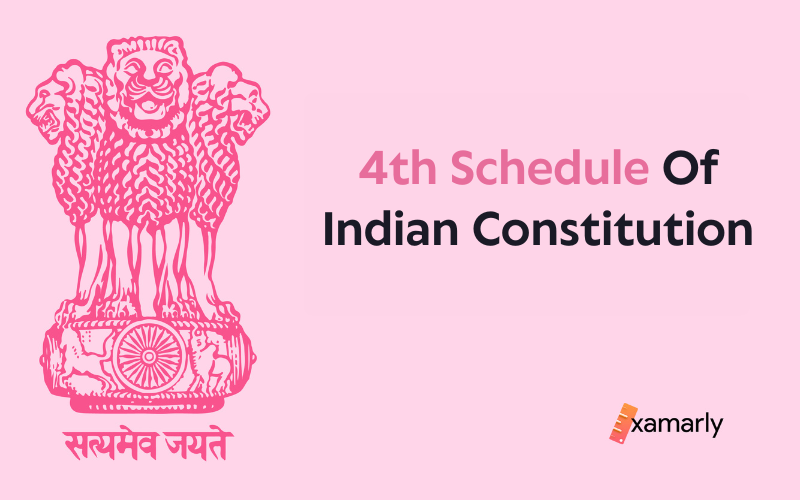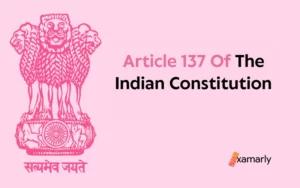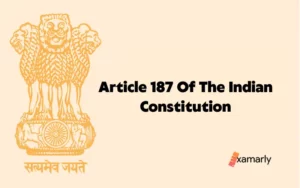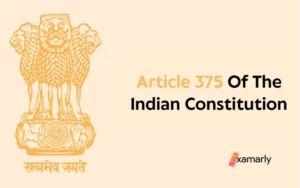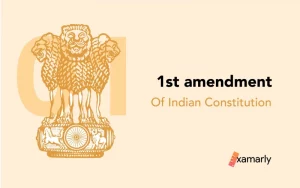The distribution of seats in the Upper House of Parliament is covered under the 4th Schedule of the Indian Constitution. The number of members varies from one state to another. In simple terms, the Fourth Schedule outlines how the Rajya Sabha seats will be distributed among the several States of India and Union Territories.
From the UPSC Exam perspective, this article will be worth reading. Schedule 4 of the Indian Constitution is a part of the Indian Polity of UPSC Syllabus.
4th Schedule Of The Indian Constitution
- Schedule 4 of the Indian constitution lays down the details of how the seats are allocated to state and union territories in the Council of States. The 7th amendment of the Indian Constitution modified this schedule.
- Article 80(2) states that the Fourth Schedule’s rules in this regard must be followed when allocating seats in the Council of States to representatives of the States and of the Union territories.
- The number of elected Rajya Sabha seats allocated to States and Union Territories has fluctuated since 1952 as a result of the restructuring of States and the creation of new States.
- There is only one representative from states like Goa, Arunachal Pradesh, Manipur, Mizoram, Sikkim, Meghalaya, Tripura, and Nagaland while there are no representatives from the Union territories of Lakshadweep, Chandigarh, Dadra, and Nagar Haveli, Daman and Diu, the Dadra and Nagar Haveli Islands, or Andaman and Nicobar Islands in the Rajya Sabha.
Main Provisions
- The Rajya Sabha may consist of no more than 250 people, as stated in Article 80 of the Constitution. Of these 250 members, 12 members are chosen by the President, and 238 members represent the States and two Union Territories.
- There are now 245 members of the Rajya Sabha. In this, 233 represent the states and union territories of Delhi and Puducherry and 12 members are chosen by the President.
From the following links, applicants can study more articles pertinent to their forthcoming UPSC Prelims Exam, UPSC Mains Exam or any other competitive exams:
History Of Fourth Schedule
- 217 people made up the Rajya Sabha when the Constitution of India was approved in the year 1949.
- The Rajya Sabha was to have 216 members when the Constitution went into effect on January 26, 1950; 12 of those members would be presidential nominees, and the other 204 would be elected representatives of the States.
- The Fourth Schedule was amended by three acts. These are –
- the Andhra State Act, 1953,
- the Bihar and West Bengal (Transfer of Territories) Act, 1956, and
- the States Reorganisation Act, 1956.
- In1954, there were 207 elective seats overall, up from 204. They further added thirteen elective seats to make it 220 in 1956.
- The 4th Schedule was also modified each time a new state was created or a change was made to existing legislation.
- Currently, the strength is 245 members. In this, 233 are representatives of the Union territories and States and 12 members are nominated by the Indian President.
Allocation Of Seats To Each State And Union Territory
| State/Union Territory Of India | Number of Seats |
| Andhra Pradesh | 11 |
| Arunachal Pradesh | 1 |
| Assam | 7 |
| Bihar | 16 |
| Chhattisgarh | 5 |
| Goa | 1 |
| Gujarat | 11 |
| Haryana | 5 |
| Himachal Pradesh | 3 |
| Jharkhand | 6 |
| Karnataka | 12 |
| Kerala | 9 |
| Madhya Pradesh | 11 |
| Maharashtra | 19 |
| Manipur | 1 |
| Meghalaya | 1 |
| Mizoram | 1 |
| Nagaland | 1 |
| Odisha | 10 |
| Punjab | 7 |
| Rajasthan | 10 |
| Sikkim | 1 |
| Tamil Nadu | 18 |
| Telangana | 7 |
| Tripura | 1 |
| Uttar Pradesh | 31 |
| Uttarakhand | 3 |
| West Bengal | 16 |
| National Capital Territory of Delhi | 3 |
| Puducherry | 1 |
| Jammu & Kashmir | 4 |
| Nominated Members | 12 |
| Total | 245 |
Conclusion
The allocation of seats with respect to States is revealed in the fourth schedule. From State to State, there are different numbers of members. Simply defined, the Fourth Schedule to the Constitution specifies how the various States and Union Territories would be allocated seats in the Rajya Sabha. The article also covers the history of the Fourth Schedule of the Indian Constitution. For General Studies Paper 2 on Indian Politics, the article is helpful.
UPSC Previous Year Questions
Q1. Which one of the following statements correctly describes the Fourth Schedule of the Constitution of India? [UPSC 2001]
(a) It lists the distribution of powers between the Union and the states
(b) It contains the languages listed in the Constitution
(c) It contains the languages listed in the Constitution
(d) It allocates seats in the Council of States
A1. d) The 4th Schedule of the Constitution details how Rajya Sabha seats are distributed to States and Union Territories. The allotment is dependent on the population of states and UTs; thus, all states and only Delhi and Puducherry have representation in the Rajya Sabha.
FAQs On The Fourth Schedule Of The Indian Constitution
Which Amendment Amended The 4th Schedule Of The Indian Constitution?
The 7th constitutional amendment amended Schedule 4 of the Indian constitution.
What Is The Rajya Sabha’s Maximum Strength?
The Rajya Sabha may have a maximum of 250 members, of whom 238 must be elected and 12 must be nominated by the President of India, as stated in Article 80.
How Many Members Does The Rajya Sabha Now Have?
Currently, there are 238 members, 12 of whom have been nominated.
Should A Rajya Sabha Member Have A Domicile In The State From Whence He Was Elected?
No. In any part of India, he must be a voter in a parliamentary constituency.


